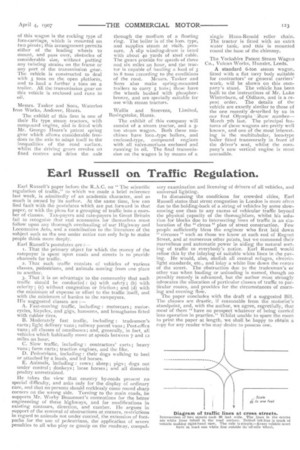Earl Russell on Traffic Regulation.
Page 17

If you've noticed an error in this article please click here to report it so we can fix it.
Earl Russell's paper before the R.A.C. on " The scientific regulation of traffic," to which we made a brief reference last week, is admittedly of an academic character, and so much is owned by its author. At the same time, few can find fault with the postulates which are put forward in that paper, or with the pleas for a grouping of traffic into a number of classes. Tax-payers and rate-payers in Great Britain fail to recognise that real economies for themselves must follow upon any thorough overhauling of our Highway and Locomotive Acts, and a contribution to the literature of the subject such as the one under notice can only help to make people think more deeply.
Earl Russell's postulates are : i. That the primary object for which the money of the ratepayer is spent upon roads and streets is to provide channels for traffic.
2. That such traffic consists of vehicles of various classes, pedestrians, and animals moving from one place to another.
3. That it is an advantage to the community that such traffic should be conducted (a) with safety ; (b) with celerity; (c) without congestion or friction; and (d) with the minimum of expense or effort to the traffic itself, and with the minimum of burden to the ratepayers. His suggested classes are :— A. Fast-moving traffic, including : motorcars ; motorcycles, bicycles, and gigs, hansoms, and broughams fitted with rubber tires.
B. Moderately fast traffic, including : tradesmen's carts; light delivery vans; railway parcel vans; Post-office vans; all classes of omnibuses; and, generally, in fact, all vehicles which habitually move at speeds between 7 and 12 miles an hour.
C. Slow traffic, including : contractors' carts; heavy vans; farm carts; traction engines, and the like, D. Pedestrians, including : their dogs walking to heel or attached by a leash, and led horses. E. Animals, including : cows; sheep ; pigs; dogs not under control ; donkeys; loose horses; and all domestic poultry unrestrained.
He takes the view that country by-roads present no special difficulty, and asks only for the display of ordinary care, and that no persons should recklessly come round sharp corners on the wrong side. Turning to the main roads, he supports Mr. Worby Beaumont's contentions for the better engineering of these highways, and for modifications in existing contours, direction, and camber. He argues in support of the removal of obstructions at corners, restrictions. in regard to animals not under control, the extension of footpaths for the use of pedestrians, the application of severe penalties to all who play or gossip on the roadway, compul
sory examination and licensing of drivers of all vehicles, and universal lighting. In discussing the conditions for crowded cities, Earl Russell states that street congestion in London is more often due to the holding-back of a string of vehicles by some slownroving one than to any excess of vehicular traffic beyond the physical capacity of the thoroughfare, whilst his solution for blocks due to intersecting lines of traffic is an elaboration of the "circus " plan of street construction. Few people sufficiently bless the engineer who first laid down " circuses " such as those we know at each end of Regent Street, and at numerous other points, but we commend their marvellous and automatic power in aiding the natural sorting of traffic to everybody's notice. Earl Russell would refine this by the inlaying of suitable white lines in the paving. He would, also, abolish all central refuges, electriclight standards, etc., and inlay a white fine down the centre of the street. The obstruction due to the tradesman's or other van when loading or unloading is named, though no possibly remedy is advanced, but the author most strongly advocates the allocation of particular classes of traffic to particular routes, and provides for the circumstances of morning and evening flow.
The paper concludes with the draft of a suggested Bill. The clauses are drastic, if reasonable from the motorist's standpoint, and, with the author, we agree, regretfully, that most of them " have no prospect whatever of being carried into operation in practice." Whilst unable to spare the room to print the paper at length, we shall be happy to obtain a copy for any reader who may desire to possess one.


























